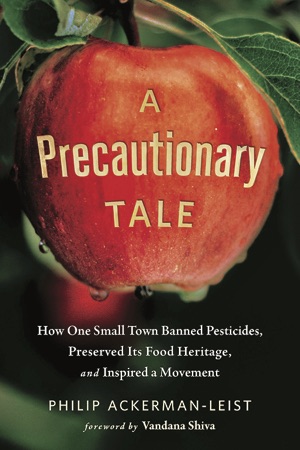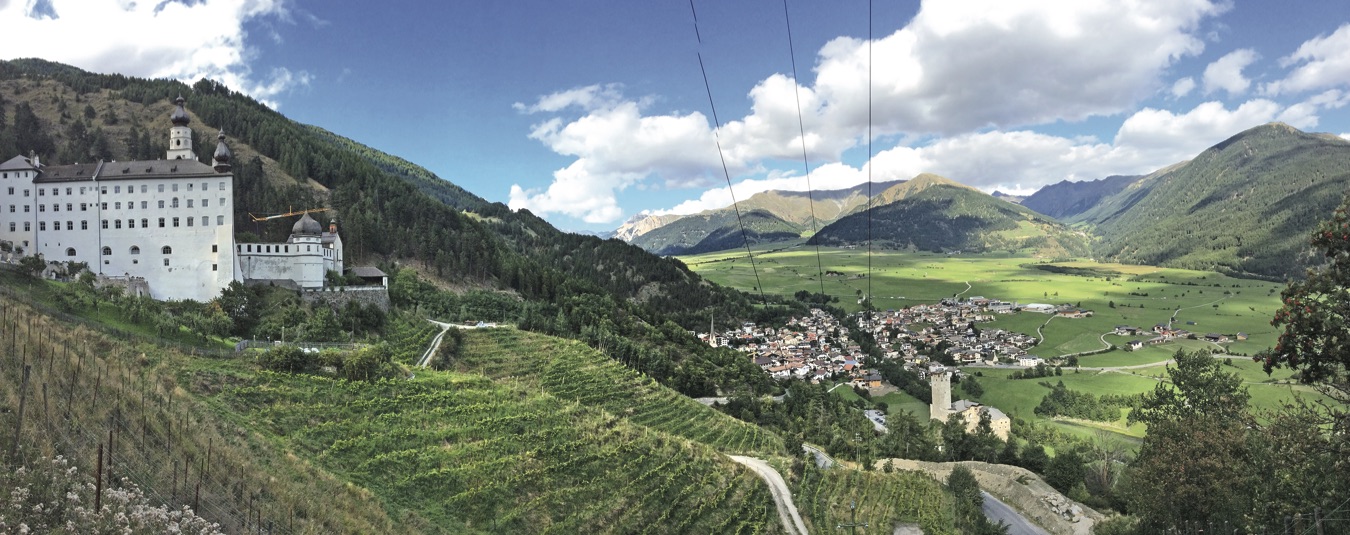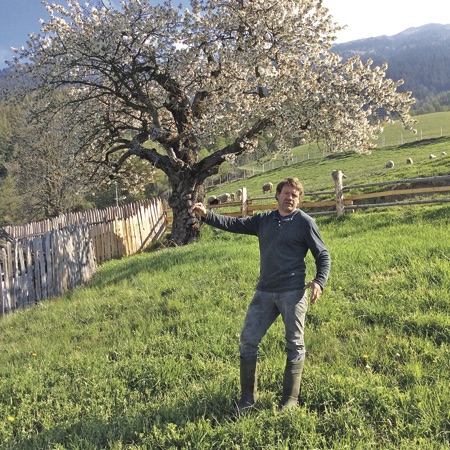
Mals is a town of 5,300 residents in the Italian Alps, nestled against the borders of both Switzerland and Austria. In 2014 the town made headlines when its citizens voted to ban pesticides, sparking a new round in the international debate over chemicals in the food system. This debate rages in the U.S., too, where farmers, consumers and environmentalists butt heads over what amount of genetic engineering, pesticides and herbicides are safe.
Philip Ackerman-Leist, a sustainable agriculture professor at Green Mountain College in Vermont, was working in Mals as the fight over pesticides unfolded. He chronicled the conflict and considered how it fits into the global debate over chemicals and food production in his book, A Precautionary Tale: How One Small Town Banned Pesticides, Preserved Its Food Heritage, and Inspired a Movement.
How did you get involved with farming?
My closest connection to farming was through my grandfather, Dr. Carlyle Clayton, who was a plant pathologist and breeder of peach tree varieties for the southeastern U.S. In addition to creating more than a dozen peach tree varieties, he also developed pesticide spray programs for various fruits in the Southeast. While he was breeding for disease resistance and characteristics that would please consumers, he believed that pesticides were the short-term solution that would complement what the slow process of plant-breeding hadn't quite achieved. The farm specialized in peaches, but Grandad grew every fruit he could in the Sandhills region of North Carolina, including grapes, nectarines, plums and melons, along with vegetables and a fruit tree nursery. Grandad wasn't shy about using synthetic pesticides, and we had a lot of long conversations about the challenges of organic fruit production. I kept looking for examples of successful organic fruit operations, which were few and far between at that time but much easier to find now.
What led you from North Carolina to northern Italy?
In 1983, I went to the South Tirol region of northern Italy for a study abroad program at Brunnenburg Castle and Agricultural Museum, a place dedicated to preserving the disappearing traditions of agriculture in the region. I was immediately smitten by the diversified agriculture I saw at the time, with farmers and their livelihoods clinging to incredibly steep mountainsides with a tenacity afforded only by deep ecological knowledge of how to survive in such harsh terrain and weather. I kept returning and eventually settled into farming there for three years in the early 1990s. Part of my job was also to take American college students to various valleys to study the nuanced agricultural history of those topographical niches. Brunnenburg Castle is perched at the entrance to the Vinschgau Valley, and Mals is at the far upper end of the valley, about a 90-minute drive from the castle. The 95-square-mile municipality of Mals always stunned my students, with its array of castles in various stages of ruin, the compact splendor of each of its eleven villages, the patchwork of pastures and hayfields, the fields of traditional grains, and iconography and architecture dating back more than a thousand years.
What kind of farm were you working on?
I was working in the vineyards and orchards of Brunnenburg Castle and Agricultural Museum, at the lower end of the Vinschgau Valley. While it was a diversified farm, much of my focus was on caring for the grapes and the wine. During the summer, I was charged with spraying the vineyards with pesticides, primarily against fungal diseases but sometimes against the European red mite. I was one of the only people in the village who wore a respirator and one of the only ones who wore much in the way of protective clothing. After three years of spraying, I decided I couldn't do it anymore and came back to the United States to try and find organic approaches to agriculture.

When did you notice the shift from traditional diversified farming to monoculture apple farming in Mals?
From 1983 forward, I watched apple orchards take over more and more of the South Tirol region, and the orchards and their trellised infrastructure kept appearing in higher and higher elevations of the Vinschgau Valley. At the upper end of the valley, Mals became one of the last bastions of traditional diversified farming in the area. Friends of mine had a rustic farmhouse on a mountainside overlooking Mals, and I would go there to get away from all of the intensified fruit production that was commandeering virtually every open space in the village where I was living. I basked in the beauty of the patchwork of agricultural possibilities that Mals put on display down below.
Was climate change somehow implicated in this upslope movement of apple orchards?
The upward march of apples was the result of a twin conspiracy led by climate change and handsome profits. As the valleys and mountainsides have warmed, even in the 35 years I've been going to Mals, apple growers have seized upon the possibility to grow apples where they'd not been grown previously, and they were afforded that opportunity by the high profits they could earn even from a few acres.
Why do you call it “Big Apple?”
“Big Apple” ironically represents the conglomeration of power created by a collection of smallholder farmers who started forming apple cooperatives in the early 20th century--cooperatives that became highly successful marketing engines, propelling the South Tirolean apple industry to becoming the largest contiguous apple-growing region in Central Europe within a matter of decades. If you eat an apple in Europe, there's a one-in-seven chance that it comes from the South Tirol. While most apple farmers own fewer than a dozen acres, when almost every farmer converts his or her land to apples, then the monocultural realities step in. Once you create a large-scale habitat for pests and diseases – and especially when it's a "perennial habitat" that doesn't allow for crop rotation to outwit the "enemies" – then you've created an imbalance and find yourself reliant upon an armory of fungicides, insecticides and herbicides.

In the book, you describe the Mals community as being largely organic by tradition. What were the practical impacts of Big Apple's drifting sprays?
With a mere 10-foot spray buffer between adjacent properties, organic farmers stood no real chance of avoiding pesticide drift, especially in a valley known for its wind that can blow for up to three weeks without ceasing. But conventional livestock farmers also didn't want their animals consuming hay or grass that was in close proximity to apple orchards. As one dairy farmer told me, “The cow is the filter,” and no farmer, organic or conventional, wants unhealthy livestock. The grain growers in the valley were just embarking on a renaissance in growing the traditional grains of the region for consumers, bakeries and restaurants, and they felt that coexistence with conventionally-managed apples was impossible. Finally, analyses of schoolyards in the region began showing that multiple pesticide residues were present at levels that alarmed the local medical community.
How did the women of Mals' approach differ from the men's?
While a number of men in Mals had been organizing forums to discuss a vision for the future of agriculture there, they hadn’t really captured the attention of the media or the regional politicians. They were also speaking in terms of possible pesticide bans. So when a few women began discussing their frustration that there was little response from the media and politicians, they decided to mount a letter-to-the-editor campaign, which elicited a strong note of concern from government officials and the apple lobby. They were so successful that they then embarked on a guerilla arts campaign that couldn’t be ignored—they decided to turn bedsheets into banners and mounted a stealthy stenciling campaign among concerned families. As they prepared their banners, a local beekeeper, Pia Oswald, reminded her colleagues that they needed to promote a positive vision of the future, not a polarizing campaign that would result in finger-pointing. At that point, the campaign evolved into calls for a “pesticide-free future” for Mals. Banners were hung up under cover of darkness late one summer night, and the next day, banners were hanging from balconies, fences and even in front of the local monastery.
The citizens of Mals believed that their calls for a pesticide-free town were tightly aligned with the “precautionary principle,” meaning that those who produce potential toxins or other dangers must prove the safety of the product instead of putting the burden of proof on citizens to prove the associated risks. The U.S. has been slow, at best, in adopting the precautionary principle in comparison to the rest of the world, and the story of Mals is yet another example of why we need to inform the public about the merits of thinking in this manner, both as voting citizens and better-informed consumers.

How would you characterize the dialogue between the farmers of Mals and the apple growers moving in below?
Many of the farmers in Mals expressed to me that it’s generally the right of a farmer to decide what to do on his or her own land. However, when those actions infringe negatively upon others, the farmer doesn’t have the right to continue those practices. Pesticide drift creates a negative impact for neighboring farms, in some cases jeopardizing their entire income, as in the case of organic farmers who not only can’t sell their products if they are contaminated with pesticide residues but can also risk losing their organic certifications if the pesticide residues persist.
There were, of course, some tempestuous debates, and even some threats of bodily harm. Some of the people promoting a pesticide-free future had their homes and other property vandalized. Nonetheless, those advocates tried to maintain an open dialog and find common ground. I certainly got an earful from fruit-growing friends in the village where I lived further down in the valley. While there were a few people outside of Mals who championed the pesticide-free initiative, most of my former fruit-growing colleagues considered the Malsers to be a fringe element from a place where people had always thought and behaved a little differently. Few suspected that the Malsers would pass a referendum with a stunning three-quarters majority, much less be able to enact precedent-setting ordinances to hopefully guarantee a pesticide-free future.
Do you know if that decision has had an effect beyond the town?
If “Big Apple” and its allies had ever suspected Mals would leap into the international spotlight, they would have paid much more attention to what they treated as the follies of “a bunch of green crazies.” Mals has become not just a beacon of hope for communities seeking to ensure the health of their people and landscapes, but also a model for how ordinary, untrained citizens can become effective advocates for sustainable agriculture. Mals is now touted as the world’s first pesticide-free community by way of a public referendum and upheld as a model throughout the European Union. Documentary filmmakers from Japan, Australia, Germany, Austria and elsewhere have descended upon Mals to tell this incredible story.
If there's one lesson I've learned from the story of Mals, it is that we have to move beyond the idea of organic farms as the answer; "organic communities" are the more sustaining and resilient objective. Philip Ackerman-Leist
When we talk about sustainable agriculture, is the goal always to use no chemicals at all? Or are chemicals sometimes necessary?
“Sustainable agriculture” is used to describe a number of management approaches, but most experts tend to agree that farming without synthetic pesticides depends upon an ecological system that is in balance, both within the farm system itself and with the surrounding ecosystem. The best approach to a pest or disease issue is to assess that ecological balance, make any necessary changes, and then follow up with any necessary organic interventions. In some cases, a farmer may decide to intervene with targeted use of a specific synthetic pesticide—a different approach to pesticide use from what the citizens of Mals were confronting. They found themselves facing an influx of apple farmers applying pesticides at quantities virtually unrivaled in Central Europe. The massive conversion of the landscape to a vast monoculture meant that pesticide drift from dozens of different chemicals sprayed 20 or 30 times a year posed a serious threat to human and environmental health in the town of Mals.
When I left my respirator and rubber suit behind in the South Tirol 25 years ago, I left behind an approach to agriculture that I was no longer willing to participate in as a farmer. What I didn’t have at that point were time-tested models for economically successful farms not reliant on synthetic pesticides. Now I’m focused on exploring beyond the farm scale and unveiling the narratives of the communities that have consciously adopted a pesticide-free future.
If there’s one lesson I’ve learned from the story of Mals, it is that we have to move beyond the idea of organic farms as the answer—“organic communities” are the more sustaining and resilient objective.
Interview by Erik Hoffner